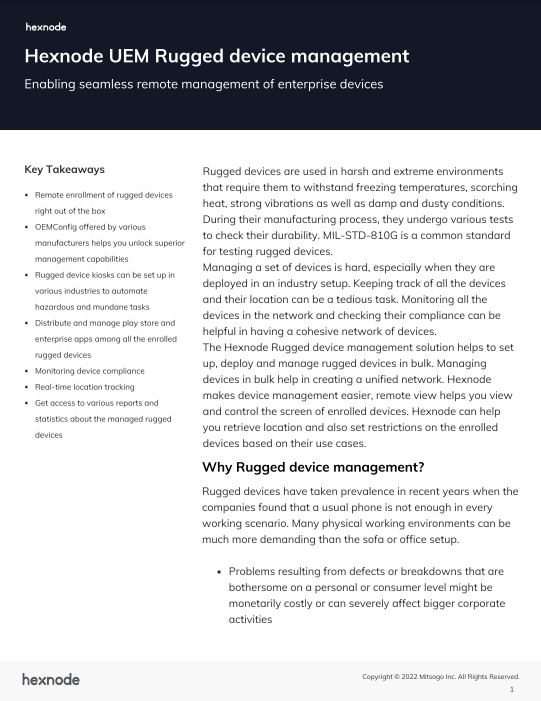What does the future of rugged device management hold in store?
The demand for rugged devices has seen unprecedented growth and is estimated to reach sky-high in the coming years.

Get fresh insights, pro tips, and thought starters–only the best of posts for you.
Celine Jones
Dec 1, 2022
6 min read

Newfound needs lead to creating the latest features or equipment that keep branching out further with time. One such branch is ‘ruggedization’ which is flourishing rapidly as a necessity in multiple fields. Like frontliners, rugged devices stand at the forefront of all device-oriented services. A resistant device immune to majorly all elements of earth also requires a hand in management. In this blog, we delve beyond the rugged bracket and chew over UEM for rugged devices. But first, some revision.
Designed to operate in harsh ecosystems, a rugged device is a category of industry-grade hardware. These devices are deployed to facilitate on-site operations even when exposed to extreme temperatures, moisture, vibration, dust, rain and any other factor that would usually hamper the physical condition of a regular device. They can be considered an extension of consumer devices but more “rugged and ready”.
Rugged devices have come a long way from portable computers to truly resilient devices that can withstand temperatures ranging from –30℃ to 60℃ and a safe drop height of up to 1.5m. There are two testing procedures that assess a device’s “ruggedness”.
In comparison to consumer-grade equipment, rugged devices are typically more expensive. Although, these devices experience fewer damages and other problems, such as breakages, which lowers the expenses associated with device ownership.
However, it’s not all rainbows and unicorns with robust gadgets. As these devices are being operated outside the office perimeters, troubleshooting becomes difficult because of distance. Moreover, they carry essential enterprise data that may be prone to cyber exploitation.
The advent of the Internet of Things has sprung up numerous opportunities including new ways for devices to connect to platforms and data centers. Thanks to the potential of smart, connected devices, enterprises may now anticipate increased efficiency, accurate data collection, and simplified workflow.
Increased connectivity has redefined the capabilities of gadgets. And IT admins ensure to maintain this level of connectivity at all times. Managing a fleet of devices in an organisation is certainly an albatross around an admin’s neck. That’s where UEM solutions land!
Expanding from MDMs, UEMs cater to an enterprise’s IT needs by providing its admins with overall visibility on all endpoints from a single console. Moreover, they can make use of many functionalities like device provisioning, endpoint management and remote troubleshooting. That makes UEM solutions an ideal agent for managing a rugged ecosystem. 
On-site rugged devices can be managed with UEMs
A lot goes into maintaining the overall performance of rugged devices. Simply shielding the device physically is not enough. A rugged gadget goes through a lot of data collection, processing, and updates. These devices need to be wrapped up in cotton wool when transmitting data. Building firewalls and identifying potential risks are just the granular steps. Moreover, in trying times and environments like factories, labs etc, distractions (internet browsing, surfing) are a big no.
With one too many requirements to propel a rugged ecosystem, we finally put the spotlight on how resilient is your UEM solution for ruggedized devices. Not every UEM solution will meet your criteria for ruggedized device management, no matter how inclusive it is. Listed below are some key attributes and capabilities you can count on from UEMs like Hexnode-
We speak for every IT admin when we say that zero-touch or over-the-air (OTA) enrollment is a key feature while looking into UEMs. Manually enrolling and configuring every device is an uphill task. Deploying a fleet of devices in a click is THE WAY to go!
With OEMConfig, UEM providers may now obtain all necessary functionality with a simplified procedure. With Android OEMConfig, businesses may create and execute their own management strategies on top of those, integrating functionality outside the jurisdiction of UEMs.
This includes Wi-Fi and VPN configurations, occasional distribution of patches, data loss prevention, password policies, policy updation etc. A UEM like Hexnode offers you a myriad of features like encryption and forced compliance to bridge any security gap.

Secure your devices by using Hexnode's tough device management capabilities to outfit them with the best security features, ready for deployment at a moment's notice.
DOWNLOAD DATASHEETYour UEM must be able to manage on-field devices remotely with certain functions pertaining to remote viewing, remote wiping, OS updates, periodic reports, geo-tracking etc.
Ensure productivity throughout the workforce by whitelisting/blacklisting apps and websites. Only keep the apps that are required and disable the rest.
Turn your field device into a completely functional, ruggedized device by enforcing kiosk restrictions. Lock down your device into a single screen on one app or multiple apps without any option for disabling the kiosk.
Quoting Hexnode’s CEO, Apu Pavithran’s piece featured on Forbes, “although an emerging UEM includes many of these functions, the kiosk lockdown capability is its most important feature when it comes to field devices”.
Ruggedized devices are becoming increasingly ingrained in our daily lives, and this trend will probably continue in the years to come.
Rugged technology is now being recognised for the many advantages it offers to individuals from various walks of life, despite being largely used in areas like construction and engineering. The proliferation of hybrid work and the rising number of cyber hazards, do not limit UEMs to an option but a must-have.
With this, we remind you to unwind, brew a mug of hot cocoa and cherish the remaining of 2022 with glee.
Happy holidays!🎄
Manage your ruggedized devices with Hexnode for 14 days, all free of cost! No credit card required.Propel a rugged ecosystem with Hexnode